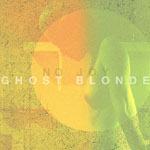|
|
 |
Dusted Reviews
Artist: No Joy Album: Ghost Blonde Label: Mexican Summer Review date: Jan. 26, 2011 |

|
|
|
 |
The art for No Joy’s first album depicts a naked woman’s torso, her face leaning down and forward in shadows, the outlines of her body obscured by a radiant overlay of green and yellow and orange. You might not even notice, the first time you look, that there’s a topless girl on display, so soft the focus, so downplayed the tones that mark her figure. In a way, that’s how No Joy’s first album works, too, wrapping the contours of two women’s voices in layers and layers of fuzz.
It’s an approach that recalls both My Bloody Valentine and Jesus & Mary Chain (especially female-assisted cuts like “Just Like Honey”), except for one critical factor. The effected guitars that swath fragile melodies are played not by male don’t-look-behind-that-curtain impresarios, but by the women themselves. Both Laura Lloyd and Jasamine White-Gluz are primarily guitar players, not vocal window dressing, and if they want to cover up girlish charms under washes of feedback and distortion…well, it’s their voice, isn’t it?
Ghost Blonde represents 10 of the 12 songs that Lloyd and White-Gluz have written together as No Joy so far. (There was a single last year with two non-album tracks.) That guitars are the main thing, not a side offering, is apparent from the very first sound you hear on the record -- a guitar-held-upside-down squawk of feedback.
Lloyd and White-Gluz got The Raveonettes’ Sune Rose Wagner to mix Ghost Blonde, adding a haze of distortion to even the prettiest, least abrasive cuts. The record really gets going about midway through with “Hawaii,” a percussion-pummeled, fuzz-crusted punk chant that sounds more like Prolapse than My Bloody Valentine. There are layers and layers of guitar effects on this cut, all slightly blurred around the edges.
“Ghost Blonde,” closing the album, is even better, heaving to life on a buzz-sawed bass line, guitar notes arcing over in eighth-note bursts, vocals buried at the bottom of a very deep well, but glinting prettily up through the murk. A dozen listens later, I’m still not sure if there’s a beautiful core here that’s half-obscured by the wrapping or whether it’s the wrapping itself that’s beautiful. Either way, it’s a remarkable finish to a very promising album.
By Jennifer Kelly
|







